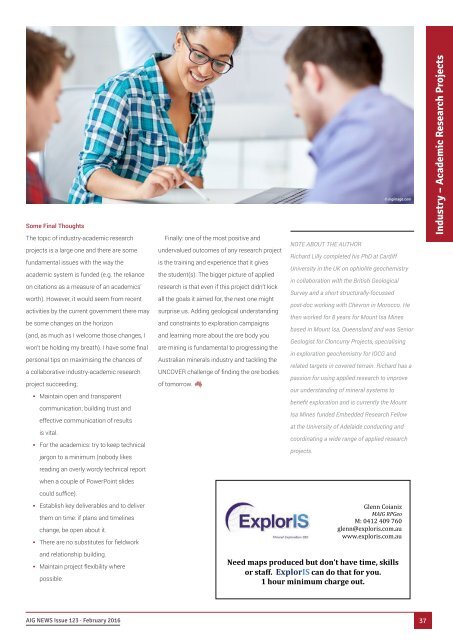Up & Coming Geoscientists - a sample of our AIG Honours Bursary Recipients
KMnJLq
KMnJLq
You also want an ePaper? Increase the reach of your titles
YUMPU automatically turns print PDFs into web optimized ePapers that Google loves.
Some Final Thoughts<br />
The topic <strong>of</strong> industry-academic research<br />
projects is a large one and there are some<br />
fundamental issues with the way the<br />
academic system is funded (e.g. the reliance<br />
on citations as a measure <strong>of</strong> an academics’<br />
worth). However, it would seem from recent<br />
activities by the current government there may<br />
be some changes on the horizon<br />
(and, as much as I welcome those changes, I<br />
won’t be holding my breath). I have some final<br />
personal tips on maximising the chances <strong>of</strong><br />
a collaborative industry-academic research<br />
project succeeding;<br />
• Maintain open and transparent<br />
communication; building trust and<br />
effective communication <strong>of</strong> results<br />
is vital.<br />
• For the academics: try to keep technical<br />
jargon to a minimum (nobody likes<br />
Finally: one <strong>of</strong> the most positive and<br />
undervalued outcomes <strong>of</strong> any research project<br />
is the training and experience that it gives<br />
the student(s). The bigger picture <strong>of</strong> applied<br />
research is that even if this project didn’t kick<br />
all the goals it aimed for, the next one might<br />
surprise us. Adding geological understanding<br />
and constraints to exploration campaigns<br />
and learning more about the ore body you<br />
are mining is fundamental to progressing the<br />
Australian minerals industry and tackling the<br />
UNCOVER challenge <strong>of</strong> finding the ore bodies<br />
<strong>of</strong> tomorrow.<br />
© ingimage.com<br />
Note about the Author<br />
Richard Lilly completed his PhD at Cardiff<br />
University in the UK on ophiolite geochemistry<br />
in collaboration with the British Geological<br />
Survey and a short structurally-focussed<br />
post-doc working with Chevron in Morocco. He<br />
then worked for 8 years for Mount Isa Mines<br />
based in Mount Isa, Queensland and was Senior<br />
Geologist for Cloncurry Projects, specialising<br />
in exploration geochemistry for IOCG and<br />
related targets in covered terrain. Richard has a<br />
passion for using applied research to improve<br />
<strong>our</strong> understanding <strong>of</strong> mineral systems to<br />
benefit exploration and is currently the Mount<br />
Isa Mines funded Embedded Research Fellow<br />
at the University <strong>of</strong> Adelaide conducting and<br />
coordinating a wide range <strong>of</strong> applied research<br />
projects.<br />
Industry – Academic Research Projects<br />
reading an overly wordy technical report<br />
when a couple <strong>of</strong> PowerPoint slides<br />
could suffice).<br />
• Establish key deliverables and to deliver<br />
them on time: if plans and timelines<br />
change, be open about it.<br />
• There are no substitutes for fieldwork<br />
and relationship building.<br />
• Maintain project flexibility where<br />
possible.<br />
Glenn Coianiz<br />
M<strong>AIG</strong> RPGeo<br />
M: 0412 409 760<br />
glenn@exploris.com.au<br />
www.exploris.com.au<br />
Need maps produced but don’t have time, skills<br />
or staff. ExplorIS can do that for you.<br />
1 h<strong>our</strong> minimum charge out.<br />
<strong>AIG</strong> NEWS Issue 123 · February 2016 37


